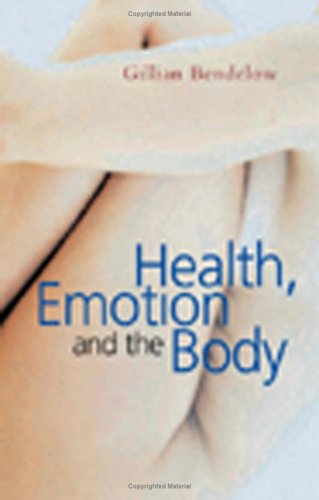Health, Emotion and the Body
Bendelow, Gillian
Polity Press, Cambridge
2009
9780745636443 (pb)
 Health, Emotion and the Body examines health in terms of the complex interplay between mind, body and society. A central concern throughout is the dualistic mind-body model of health, which forms the foundations of healthcare treatment in Britain. Bendelow argues convincingly that the limitations of the biomedical approach have driven a gradual paradigm shift towards more integrated models. There are a number of case studies throughout the book providing a valuable human element to the themes discussed.
Health, Emotion and the Body examines health in terms of the complex interplay between mind, body and society. A central concern throughout is the dualistic mind-body model of health, which forms the foundations of healthcare treatment in Britain. Bendelow argues convincingly that the limitations of the biomedical approach have driven a gradual paradigm shift towards more integrated models. There are a number of case studies throughout the book providing a valuable human element to the themes discussed.
Chapter one outlines the 'biomedical model' as the dominant paradigm of a scientific, evidence-based approach to health and medicine. It is based on the Cartesian separation of body and mind and prioritises rationality over emotion. The biomedical model has become widely contested in favour of value-based approaches, even from within the medical profession, in order to meet the changing health and care needs of contemporary society. In the second chapter Bendelow argues that the lived physicality of stress often defies attempts to separate its physical and emotional elements. Physiologically we know that stress-related diseases follow from excessive and prolonged demands on an organism's coping resources, yet this is rarely conceptualised beyond the individual. Bendelow argues that stress provides a crucial link between mind and body as well as between the individual and society. With its dualistic approach, the biomedical model tends unsatisfactorily to relegate psychosocial factors to psychosomatics.
The interconnected nature of bodily and emotional health is continued in the third chapter. The biomedical approach fails to explain problems where there are no physiological signs and, Bendelow argues that in their proliferation, 'medically unexplained symptoms' have become open to cultural interpretation and manipulation. An example is Attention Deficit Hyperactivity Disorder (ADHD), the contemporary over-diagnoses of which may be driven by the cultural pressure to 'normalize' children. The alarming possibility is that we have become overly-medicalized: a 'quick-fix culture' where any problem is treatable with drugs.
The fourth chapter contains the most compelling of the case studies: the story of a woman's life-long struggle with depression and psychotropic treatment. The story provides a poignant backdrop to Bendelow's examination of the history of psychological care, pharmaceuticals and psychiatry. Originally seen as progressive, Bendelow says that pharmaceuticals later became vastly oversubscribed, particularly with the growth of GP subscription. Bendelow describes the dubious role psychiatry has played in diagnosing certain behaviours as medical conditions which can treated with drugs. In this way pharmaceutical treatment has traditionally sat rather ambiguously between treatment and form of social control. The underlining point is that we have had a somewhat unhealthy dependence on drugs when it comes to treating emotional and psychological distress. In contrast, a limited use of drug prescription, such as in the treatment of schizophrenia for example, has been shown to have better outcomes for the patient.
Chapter five looks at the people who are turning to alternative treatments, such as acupuncture and reflexology. Mainly they are looking for a sense of value and wellbeing: something more then just 'popping pills' (as a patient in one case study said). However, with a wide variety of complementary treatments available, it's difficult to know which are legitimate and the best for you. Many healthcare professionals are keen to advise patients about complementary treatment but lack the necessary information. Bendelow points out that, whatever the opinion on non-mainstream therapy, doctors should encourage patients to try treatments that can enhance their emotional wellbeing as well as provide them with safe and accurate information.
Evidence-based medical practice is clearly fundamental to effective healthcare. But, despite its benefits, biomedicine has perhaps led us to forget that medicine is about the patient not just their disease. In the final chapter Bendelow posits the holistic 'mind-body-society' model of health as one that balances biological, emotional and environmental factors. A holistic approach does not necessarily mean the heavy-handed state intervention of 'healthism'. Bendelow proposes resisting individualism and rescuing holism by studying health at the very interconnections between medical models, cultural practices, biological activities and contexts that are rooted in social structures. The conclusion is a thought-provoking challenge to look beyond biological- verses cultural-determinism towards a genuinely integrated understanding.
Health, Emotion and the Body is an accessible book that manages to packin a great deal of information. Bendelow has made effective use of a breadth of issues from pharmaceuticals to feminism whilst tying the chapters together nicely. This book would be particularly suited to students and scholars of medical sociology or health-related subjects. Having said that, the clarity of the writing and weight of information means that Health, Emotion and the Body also has a great deal to offer newcomers.
Paul Whybrow
University of Edinburgh

